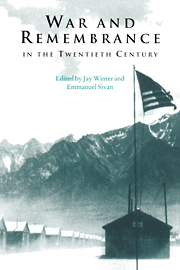Book contents
- Frontmatter
- Contents
- Preface
- Introduction
- 1 Setting the framework
- 2 Forms of kinship and remembrance in the aftermath of the Great War
- 3 War, death, and remembrance in Soviet Russia
- 4 Agents of memory: Spanish Civil War veterans and disabled soldiers
- 5 Children as war victims in postwar European cinema
- 6 From survivor to witness: voices from the Shoah
- 7 Landscapes of loss and remembrance: the case of Little Tokyo in Los Angeles
- 8 The Algerian War in French collective memory
- 9 Private pain and public remembrance in Israel
- 10 Personal narratives and commemoration
- 11 Against consolation: Walter Benjamin and the refusal to mourn
- Index
- Studies in the Social and Cultural History of Modern Warfare
7 - Landscapes of loss and remembrance: the case of Little Tokyo in Los Angeles
Published online by Cambridge University Press: 27 October 2009
- Frontmatter
- Contents
- Preface
- Introduction
- 1 Setting the framework
- 2 Forms of kinship and remembrance in the aftermath of the Great War
- 3 War, death, and remembrance in Soviet Russia
- 4 Agents of memory: Spanish Civil War veterans and disabled soldiers
- 5 Children as war victims in postwar European cinema
- 6 From survivor to witness: voices from the Shoah
- 7 Landscapes of loss and remembrance: the case of Little Tokyo in Los Angeles
- 8 The Algerian War in French collective memory
- 9 Private pain and public remembrance in Israel
- 10 Personal narratives and commemoration
- 11 Against consolation: Walter Benjamin and the refusal to mourn
- Index
- Studies in the Social and Cultural History of Modern Warfare
Summary
How many people are buried here?
Question from reporter at site of camp cemetery, Manzanar, California, 1973A whole generation. A whole generation of Japanese who are now so frightened they will not talk.
Reply by former camp inmateWar disrupts and reconfigures attachments to cultural landscapes on an unprecedented scale. The process of mourning for the losses of war often involves memories of treasured places, and human connections within those places. Mourning also involves memories of hated or feared places such as the front line or the concentration camp. This essay explores the ways in which cultural landscape history can be used to frame the connections between places, memories, and public history. It looks at the possibilities of individual and community-based spatial histories for processes of collective remembrance. It focuses in particular on how spatial histories have been used in Little Tokyo in Los Angeles, first, by former inmates of War Relocation Authority (WRA) camps as part of an exhibit at the Japanese American National Museum, and second, in historic preservation and public art for the First Street Historic District (of which the museum is part).
The production of space
Every society in history has produced a distinctive social space that meets its intertwined requirements for economic production and social reproduction. Space is a material product of the political economy. As Henri Lefebvre has written, ‘Space is permeated with social relations; it is not only supported by social relations but it is also producing and produced by social relations.’
- Type
- Chapter
- Information
- War and Remembrance in the Twentieth Century , pp. 142 - 160Publisher: Cambridge University PressPrint publication year: 1999
- 2
- Cited by



